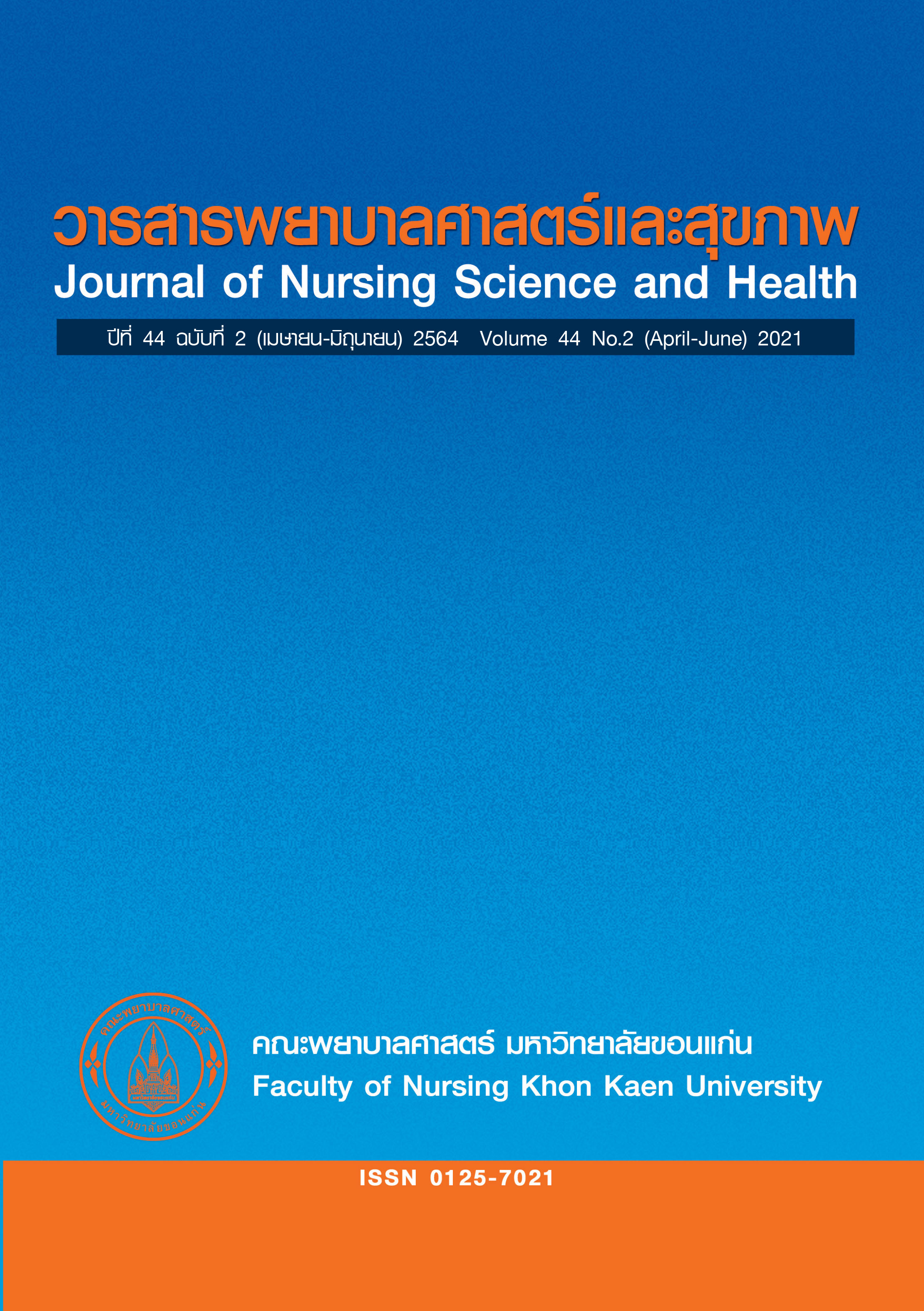การพัฒนารูปแบบการจัดการความปวดของผู้คลอดในระยะที่หนึ่งของการคลอด
คำสำคัญ:
รูปแบบการจัดการความปวด, การวิจัยเชิงปฏิบัติการ, การคลอดระยะที่ 1บทคัดย่อ
การวิจัยเชิงปฏิบัติการนี้ มีวัตถุประสงค์เพื่อพัฒนารูปแบบการจัดการความปวดของผู้คลอดในระยะที่หนึ่งของการคลอด โดยมีขั้นตอนการศึกษาตามแนวคิดของ Kemmis & Mc Taggart ประกอบด้วย 4 ขั้นตอนอย่างต่อเนื่องดังนี้ 1) วางแผน 2) ปฏิบัติการ 3) สังเกตและรวบรวมข้อมูล 4) ติดตามและประเมินผลการปฏิบัติงาน ดำเนินการพัฒนาอย่างต่อเนื่อง 2 วงจร ผู้เข้าร่วมวิจัยเป็นพยาบาลวิชาชีพที่ปฏิบัติการในแผนกห้องคลอด จำนวน 14 คน และหญิงตั้งครรภ์ที่มีอายุครรภ์ 37 สัปดาห์ขึ้นไปที่มาฝากครรภ์และวางแผนการคลอดทางช่องคลอดที่แผนกฝากครรภ์และมาคลอดที่โรงพยาบาลขอนแก่น จำนวน 260 คน ในระหว่างเดือนกุมภาพันธ์ ถึงตุลาคม พ.ศ. 2562 เครื่องมือที่ใช้ในการวิจัยประกอบด้วย 1) แบบประเมินการเผชิญความเจ็บปวดและการจัดการความปวดของผู้คลอด 2) แบบสอบถามความพึงพอใจของพยาบาลวิชาชีพและ 3) แบบสอบถามความพึงพอใจของผู้คลอดที่เข้าร่วมโครงการ ตรวจสอบความตรงเชิงเนื้อหาจากผู้เชี่ยวชาญจำนวน 5 ท่าน หลังจากนั้นพยาบาลได้นำเครื่องมือไปเก็บข้อมูลทำการศึกษา และประเมินผลการศึกษา โดยประเมินการเผชิญความเจ็บปวดและการจัดการความปวด ในระยะที่ 1 ของการคลอด และความพึงพอใจของผู้คลอดเมื่อครบ 2 ชั่วโมงหลังคลอด วิเคราะห์ข้อมูลด้วยการใช้สถิติเชิงพรรณนา
ผลการศึกษา รูปแบบการจัดการความปวดของผู้คลอดในระยะที่หนึ่งของการคลอด ประกอบด้วย 1) การสอนและฝึกปฏิบัติในการจัดการความปวดของหญิงตั้งครรภ์อายุครรภ์ 37 สัปดาห์ขึ้นไปที่งานฝากครรภ์ 2)การปฏิบัติการพยาบาลของพยาบาลห้องคลอดและการปฏิบัติตัวของผู้คลอดในจัดการความปวดเมื่อเข้าสู่ระยะที่ 1ของการคลอด ผู้คลอดที่เข้าร่วมโครงการสามารถเผชิญความปวดได้อย่างเหมาะสม (ร้อยละ 97.3) และผู้คลอดมีความพึงพอใจต่อรูปแบบการจัดการความปวดในระดับมากที่สุด (ร้อยละ 95) นอกจากนี้พยาบาลที่เข้าร่วมวิจัยสามารถปฏิบัติกิจกรรมการพยาบาลตามรูปแบบที่พัฒนาขึ้นร้อยละ 100 และมีความพึงพอใจต่อการนำรูปแบบที่พัฒนาไปใช้ดังนี้ 1) ทำให้มีปฏิสัมพันธ์กับผู้คลอดได้ดี (ร้อยละ 95.7) 2) มีประโยชน์ต่อผู้คลอด (ร้อยละ 95.7) 3) มีความง่ายและสะดวกต่อการนำไปปฏิบัติ (ร้อยละ 91.4) พยาบาลที่ปฏิบัติงานในห้องคลอดพึงพอใจในการใช้รูปแบบการจัดการความปวดของผู้คลอด รูปแบบการจัดการความปวดนี้สามารถลดระยะเวลาการคลอดที่ยาวนานได้ และสามารถนำไปประยุกต์ใช้ในโรงพยาบาลอื่น ๆที่มีบริบทใกล้เคียงกัน
เอกสารอ้างอิง
Sansiriphun N, Parisunyakul S. Nursing care in labor concept of theory into practice. Chiang Mai: Krong ChangPrinting;2015. (in Thai)
Esscott D, Slade P, Spiby H. Preparation for pain management during child birth: The psychological aspects of coping strategy development in antenatal education. Clinical Psychology Review 2009;29(7):617-22.
Chaillet N, Belaid L, Crochetière C, Roy L, Gagné G, Moutquin JM, et al. Nonpharmacologic approaches for pain management during labor compared with usual care: A meta-snalysis. Birth 2014;41(2):122-37. doi: 10.1111/ birt.12103
Arayajaru P, Serisathien Y, Yusamran C, Phahuwatanakorn W. Impact of a educating programme on teenage first-time mothers’ childbirth anxiety, pain levels and pain-coping behaviour. Thai Journal of Nursing Council 2012;27(4):96-108. (in Thai)
Peinjing P, Veeraskul L, Yarungsee B, Suckchareng P, Promjan S. Effect of the preparation for childbirth program on maternal knowledge of labor, pain-coping behavior during labour in primiparas. Thai Journal of Nursing Council 2001;16(3):25-35. (in Thai)
Taghinejad H, Delpisheh A. Comparison between massage and music therapies to relieve the severity of labor pain. Women Health 2010;6(3):377-81.
Panthongchai S, Yusamran C, Pahuwattanakorn W. Effects of self-efficacy enhancing program during childbirth on pain coping behavior in nulliparous women. Kuakarun Journal of Nursing 2017;24(1):130-46. (in Thai)
Diaz AG, Schwarcz R, Fescina R, Caldeyro-Barcia R. Vertical position during the first stage of the course” of labor, and neonatal outcome. European Journal of Obstetrics & Gynecology and Reproductive Biology 1980;11(1):1-7.
Duangmani K. Effects of modified bhadrasana pose on labor pain and duration of active phase in parturients. Princess of Narathiwas University Journal 2015;9(1):35-49. (in Thai)
Khon Kaen Hospital. Report of the hospital quality indicators. Khon Kaen: Khon Kaen Hospital; 2016. (in Thai)
Carr W, Kemmis S. Becoming critical: Education, knowledge and action research. London: Falmer; 1986.
Baosoung C. The effects of planned instruction and touching on anxiety level and coping behavior during labor. [Master of Science thesis Maternal and Child Nursing Program]. Nakhon Pathom: Graduate school, Mahidol University; 1983.
Wong DL, Hockenberry-Eaton M, Wilson D, Winkelstein ML, Ahmann E, DiVito-Thomas PA, et al. Whaley and wong’s nursing care of infants and children. 6th ed.St. Louis: Mosby; 1999.
Kaewsiri P, Chuamuangsan D. Non-pharmacological approaches to management of labor pain. Journal of Nakhon Phanom University. TheBCNN25thAnniversaryConference 2020; 173-80. (in Thai)
Anusornteerakul S, Kittiprisada P. The effects of health education program and relative assistanton pain, fear, anxiety in primiparous during the first stage of labor. Journal of Nursing Science & Health 2013;36(1);23-30. (in Thai)
Mertz M, Earl C. Labor pain management. In Miller RD, Eriksson LI, Fleisher LA, Wiener-kronish JP, Young WL, editors, Miller’s anesthesia. 7th ed. USA: Churchill Livingstone; 2009:482-9.
Panichkul P. Pain management. In Phuphong W. editors, Management of common problems inobstetrics. Bangkok: The Royal Thai College of Obstetricians; 2012. (in Thai)
Lertsakornsiri M. Nursing care during pregnancy and delivery. 2nd ed. Bangkok: Faculty of Nursing Saint Louis Colleage;2015. (in Thai)
ดาวน์โหลด
เผยแพร่แล้ว
รูปแบบการอ้างอิง
ฉบับ
ประเภทบทความ
สัญญาอนุญาต
ลิขสิทธิ์ (c) 2021 วารสารพยาบาลศาสตร์และสุขภาพ

อนุญาตภายใต้เงื่อนไข Creative Commons Attribution-NonCommercial-NoDerivatives 4.0 International License.
วารสารพยาบาลศาสตร์และสุขภาพเป็นเจ้าของลิขสิทธิ์ในการเผยแพร่ผลงานที่ตีพิมพ์ห้ามผู้ใดนำบทความที่ได้รับการตีพิมพ์ในวารสารพยาบาลศาสตร์และสุขภาพไปเผยแพร่ในลักษณะต่าง ๆ ดังนี้ การนำบทความไปเผยแพร่ออนไลน์ การถ่ายเอกสารบทความเพื่อกิจกรรมที่ไม่ใช่การเรียนการสอน การส่งบทความไปตีพิมพ์เผยแพร่ที่อื่น ยกเว้นเสียแต่ได้รับอนุญาตจากวารสารพยาบาลศาสตร์และสุขภาพ



